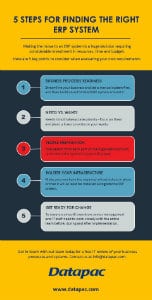By Simaak Hameed, business solutions consultant, Datapac
Making the move to an ERP system is a huge decision for any organisation. It requires considerable investment in terms of resources, time and budget, and once it has been implemented; it’s with you for the next few years at least. It’s crucial to get it right.
The main decisions to be made are choosing the right solution within your budget and the right implementation partner – it sounds simple but this is an area on which many organisations fall down.
Even with a top quality ERP system and a reputable implementation partner, organisations often make the fundamental mistake of not evaluating their own unique ERP requirements. This is actually the first and most important part of the lead-in process before any purchasing decision should be made.
This process will then inform the investment decision in the optimal ERP system and the implementation partner that best suits your needs.
Here are five key points to consider when evaluating your own requirements:
- Business process readiness
- Needs v. wants
- People preparation:
- Bolster your infrastructure
- Get ready for change
Many organisations make the mistake of believing a computerised system can streamline their business processes. This simply can’t be done and organisations should actually look at it the other way around. Find a way to streamline your business, perhaps set up a manual system first and then build an automated ERP system around it.
The never ending debate. In our opinion, needs must always take priority – focus on them and place a lower priority on your wants.
An ERP system is a tool but one that is driven by people. In addition to being IT literate it is very important that the people who are going to use the system are knowledgeable in their area of work. At least one person per operation or department needs to know what is going to go into the system (input) and what is expected from the system (output).
Make sure you have the required infrastructure in place or that it will at least be installed alongside the ERP system. Whether you opt for an on-premise or cloud ERP solution, it is imperative the system performance is carefully considered. Even with ERP processes that deliver an optimal solution, poor system performance can create a negative reaction from users and an overall bad impression of the system. This does not only mean having a high end server with terabytes of space. You should also consider factors such as LAN/ WAN speed, availability and speed of connectivity for remote access devices such as smart phones, tablets etc.
Change management is a huge challenge that comes with implementing an ERP system. Members of your team may have been using existing processes for years and the very introduction of ERP can have a significant impact on their role. Senior management and IT staff need to work closely with the entire team before, during and after implementation to ensure a smooth transition.
Getting the above steps correct puts your organisation on the path to the most effective ERP system, but don’t forget to carefully consider the right implementation partner.
Datapac has been providing affordable, scalable and adaptable ERP and Business Management Applications to Irish organisations for more than 30 years. We partner with leaders such as Microsoft to help you assess your organisation’s requirements and goals to find the right ERP system for you.
Find out more about how Datapac can implement the right ERP system for your organisation. Get in touch with our team today.
More in this section
ERP Infographic
5 steps for finding the right ERP System
View here!
Register for upcoming events
-
 "At Barretstown, we rebuild the lives of children, and their families, affected by childhood cancer and other serious illnesses. We serve 5,000 campers a year and have 1200 volunteers each year. Communication is crucially important and Datapac has helped us to streamline, improve and ensure efficiency."
"At Barretstown, we rebuild the lives of children, and their families, affected by childhood cancer and other serious illnesses. We serve 5,000 campers a year and have 1200 volunteers each year. Communication is crucially important and Datapac has helped us to streamline, improve and ensure efficiency." -
 "Datapac has provided us with a fantastic product and world-class levels of service and support. Whenever people ask me about our experience with Datapac I’m always ready to sing their praises and I would happily recommend their services to any organisation."
"Datapac has provided us with a fantastic product and world-class levels of service and support. Whenever people ask me about our experience with Datapac I’m always ready to sing their praises and I would happily recommend their services to any organisation." -
 "For many years Datapac has been our sole supplier for the maintenance of Personal Computers and Peripherals in Ireland. Through their Service Centres in Wexford and Dublin, Datapac provides excellent support to our businesses throughout the country and consistently meets the SLA targets which we have set. The skill, expertise and experience of their engineers and other technical support personnel are of the highest standard."
"For many years Datapac has been our sole supplier for the maintenance of Personal Computers and Peripherals in Ireland. Through their Service Centres in Wexford and Dublin, Datapac provides excellent support to our businesses throughout the country and consistently meets the SLA targets which we have set. The skill, expertise and experience of their engineers and other technical support personnel are of the highest standard." -
 “The value of dealing with an HP Gold partner in this process can’t be underestimated. Datapac provide us with a local touch and can cover the full range of our IT requirements, but when there is a specific technical requirement like this, they can bring the specialist technical resources of HP to the table. HP and Datapac had a thorough discussion with us around our requirement - and had really done their homework - and then were able to provide us with a very highly specified test platform for us to prove the application on before we committed to purchase.”
“The value of dealing with an HP Gold partner in this process can’t be underestimated. Datapac provide us with a local touch and can cover the full range of our IT requirements, but when there is a specific technical requirement like this, they can bring the specialist technical resources of HP to the table. HP and Datapac had a thorough discussion with us around our requirement - and had really done their homework - and then were able to provide us with a very highly specified test platform for us to prove the application on before we committed to purchase.” -
 Datapac understands our needs and requirements and has the expertise and experience to follow through on all our requests. Our constant need to reduce costs has been assisted by Datapac's ability to suggest alternative solutions and methods whilst improving both efficiency and productivity. Our partnership with Datapac is akin to having an IT department on site that we simply could not provide ourselves.
Datapac understands our needs and requirements and has the expertise and experience to follow through on all our requests. Our constant need to reduce costs has been assisted by Datapac's ability to suggest alternative solutions and methods whilst improving both efficiency and productivity. Our partnership with Datapac is akin to having an IT department on site that we simply could not provide ourselves.
